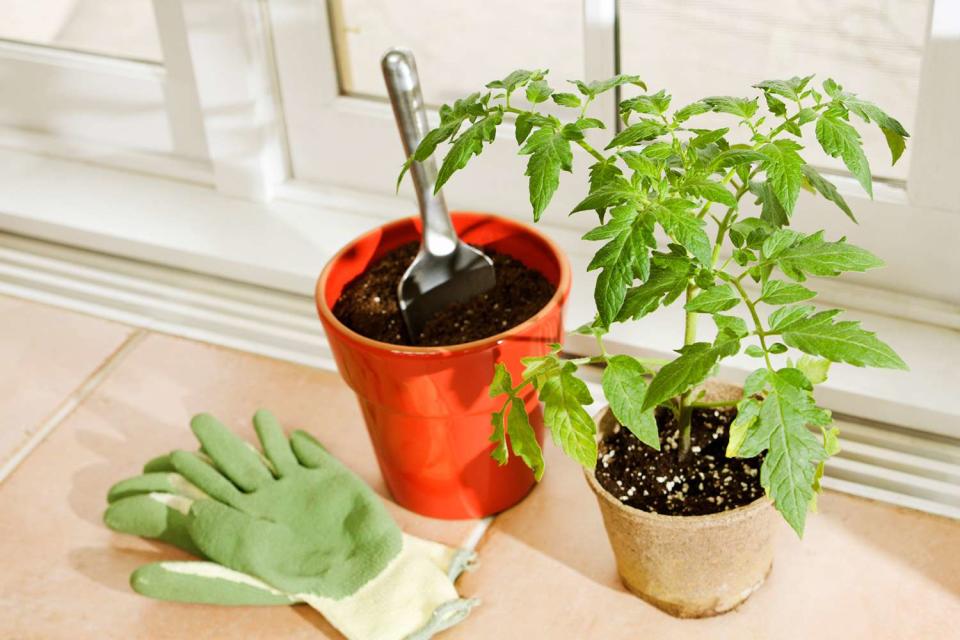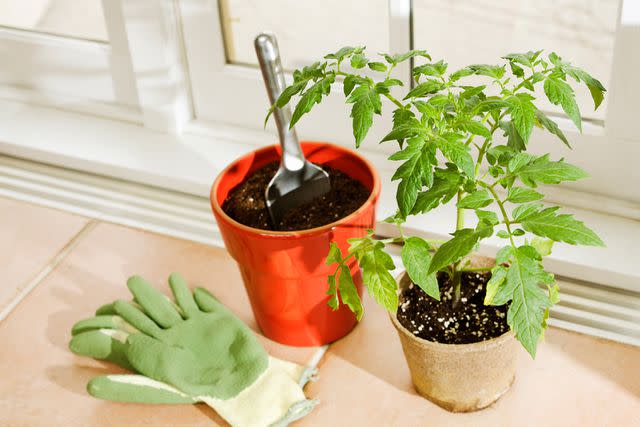10 Must-Know Tips for Growing Tomatoes Indoors
Yes, you can grow tomato plants indoors. Here's how to get a delicious harvest of your own.

YinYang / Getty Images
Bypass lackluster grocery store tomatoes this winter. Instead, grow your own indoor crop of salad-size tomatoes. Tomato plants do best growing outdoors, but with some special care they can grow, flower, and fruit indoors too. A combination of art and science, cultivating a crop of indoor tomatoes is a labor of love. Don’t expect to harvest enough to preserve but do expect to harvest tasty little tomatoes to top salads, garnish side dishes, and provide a flavor burst for favorite appetizers. These 10 must-know tips for growing tomatoes indoors will help you enjoy a few delicious gems that are especially welcome in the off-season.

YinYang / Getty Images
1. Strong, Bright Light is Essential
A set of grow lights takes the place of the sun when growing indoor tomatoes. The sunlight available indoors, especially in winter, is rarely strong enough to provide the fuel a tomato plant needs to grow and produce fruit. Even the sunlight streaming in a south-facing window falls short of what a tomato plant needs to thrive.
A simple set of grow lights or shop lights, available at garden and home centers, suspended a few inches above the top of the plants will encourage strong growth. Be sure to keep the lights within 6 inches of the top of the plants. Intensity of light coming from the light source decreases rapidly the further a light is away from the plant. Seedlings and young tomato plants require about 18 to 22 hours of supplemental light per day when growing indoors. Plants with fruit that are coloring and ripening don’t need as much light and can be moved to a south-facing window.
Related: The 12 Best Grow Lights to Help Your Plants Thrive in 2023
2. Choose Small, Compact Varieties
The best tomatoes to grow indoors are varieties labeled “patio” or “bush.” Specially selected to be small, compact plants, these types thrive in the confines of a container. Traditional varieties, such as ‘Celebrity’ and many of the heirlooms, are far too large to grow successfully indoors. Expect to find patio or bush tomato varieties that produce cherry, grape, Roma, and small slicer type fruit. Great varieties for growing in containers indoors include ‘Patio Choice Yellow,’ ‘Tumbler,’ ‘Bush Early Girl,’ and ‘Atlas.’
"Kitchen Minis" are petite, tabletop size plants available at home centers and some grocery stores. These small plants are sold with fruit on them. Simply place them in a bright, sunny window and watch the fruit ripen over a few weeks.
3. Provide Heat at Seed Starting
Speed up germination of an indoor tomato crop by providing heat under seed starting trays. Simply set seed trays on top of a gentle source of heat, such as a heat mat, radiator on low heat, or the top of a refrigerator. A few degrees of heat will kickstart germination within just a couple of days. The faster seeds germinate, the sooner you’ll be harvesting fruit.
4. Transplant to a Large Pot
When a tomato seedling is 6 inches tall and has several sets of leaves, transplant it to a large container filled with fresh potting mix. The container should be at least 14 inches wide. The best containers for tomato plants are at least 20 inches deep. The larger the container, the more the roots can expand. And make sure the container has drainage holes in the bottom. Place the pot in a saucer or tray to catch excess water that will flow out of the drainage holes.
Related: The 13 Best Potting Soils for Indoor and Outdoor Plants
5. Find a Consistently Warm Spot
Tomatoes grow well indoors when temperatures are 70 to 80°F. Cold drafts from an open door or window will shock heat-loving tomato plants. Find a growing location that is shielded from cold drafts. Be mindful of blasts of hot air from furnace vents as well. Tomatoes grow well in 70 to 80°F temperatures.
6. Keep Plants Moist but Not Wet
Tomatoes growing indoors require more regular watering than plants growing in the garden. Check water needs daily by touching the soil. If the soil is moist, don’t water and check again the next day. If the soil is dry, water the plant until water runs out the drainage holes. Use a pot saucer or large tray to catch excess water. Dump the saucer or tray within 30 minutes of watering to ensure the soil doesn’t become waterlogged.
7. Fertilize Regularly
Tomatoes growing indoors fruit best with regular fertilization. Mix a slow-release pelleted plant food into the potting mix at planting time and add pellets at intervals recommended on the package. Or fertilize with a water-soluble fertilizer solution for edible plants weekly. The frequent watering that container-grown tomatoes require removes valuable nutrients from the potting soil; replenish the nutrients by fertilizing regularly.
8. Help with Pollination
Indoor plants need your help to ensure pollination occurs. Tomatoes are self-pollinating, which means they don’t need pollen from a different plant to set fruit. When plants begin to bloom, gently shake them daily, mimicking how wind moves plants growing outdoors. The gentle shaking will promote pollination and fruit set. An oscillating fan can produce similar results.
9. Turn Plants as Needed
Promote strong, upright stems and branching by turning plants frequently. Rotation isn’t needed for plants illuminated by overhead grow lights but a tomato plant growing in a sunny window benefits from a quarter-turn every week. When not turned, plants will bend toward the light.
Related: 6 Simple Tips for Pruning Tomato Plants to Increase Your Harvest
10. Stake Your Tomato
Indoor tomato plants often have weaker stems than their outdoor counterparts. Help plants stand tall with the weight of ripening fruit by sinking a 3-foot-tall or so bamboo stake into the soil beside the main stem. Use strips of cloth to gently tie the stem to the stake. Add more ties as the plant grows.
For more Better Homes & Gardens news, make sure to sign up for our newsletter!
Read the original article on Better Homes & Gardens.

